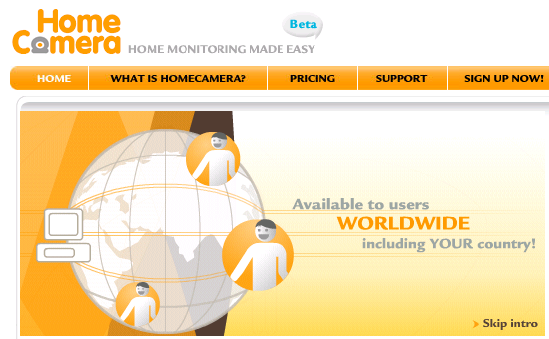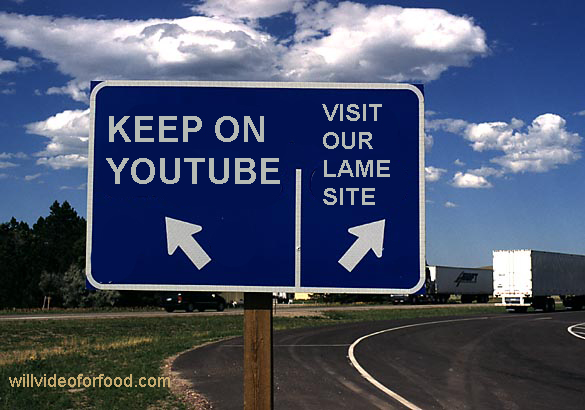 Memelabs has a platform for running viral-video contests. Didn’t know that existed until now, and it seems to make sense. It’s a better alternative to a “throw away” site that is custom designed by an agency. No big clients yet, but a number of active contests.
Memelabs has a platform for running viral-video contests. Didn’t know that existed until now, and it seems to make sense. It’s a better alternative to a “throw away” site that is custom designed by an agency. No big clients yet, but a number of active contests.
Category Archives: Contest
The Marketeter’s Cheat Sheet to Viral Video
 You’re running a brand that is trying to “dip your toe” into social media and online video, and you’re facing some important questions:
You’re running a brand that is trying to “dip your toe” into social media and online video, and you’re facing some important questions:
- Is my brand right for this?
- How can I experiment without ending up as a “case study” failure?
- Can I convince my company that we should do this?
- What are my options for developing compelling content and distributing it widely?
Here’s a quick guide that encompasses a lot of topics we’ve covered on this blog. It’s the “least a marketer or agency needs to know” about online video, and will give you a roadmap for a good program.
- Step 1: Determine if your brand is right for online video. Is your brand compelling and simple, or complex and direct-response oriented? If you’re a consumer-product goods (CPG), it’s a no-brainer. If you’re in a complex, crowded, regulated and boring industry, it’s going to be more difficult.
- Step 2: Keep it quiet. The more senior management and attorneys you bring into a pilot, the more internal battling you’ll do before experimenting. Get some “air cover” from an executive sponsor, and avoid excessive internal scrutiny.
- Step 3: Let go. Your marketing message is critical to you, but if your content is driven by an advertising objective it’s at risk of being a flop. If you want to go viral, you’ve got to entertain first and promote subtly. There are countless case studies on this, and it’s an inarguable fact. If you buy media, your ads can be boring. But if you expect people to share your video, it better be entertaining, provocative, sexy, funny, outrageous or at least interesting.
- Step 4: Develop a creative brief. Don’t make it too narrow, but give it some focus. If you ask people to make a funny video that includes your brand, you’ll get a lot of stuff that may or may not support your objective. But if you require creators to insert a series of “unique selling propositions” then you’ll end up with ads instead of entertaining videos. With my smaller clients, I develop the brief. Larger clients often already have one, and simply need ideas or video content.
- Step 5: Engage creators. You have four options here.
- Option one, you can hire your agency to create video content. This gives you control, but most agencies (advertising, online, and public relations) lack experience in social media and online video in particular. I’ve found this to be extremely expensive, and often the agencies lack the expertise to make the videos “not suck” and get the videos widely viewed and “seeded” in the right places.
- Option two, you can hire individual amateurs. This gives you access to people that know the medium and have established audiences. Some smaller brands (and larger ones) contract directly with people like me, InvisibleEngine, Rhett & Link and Barely Political (just a few creators that are interested in building entertaining, promotional content). This keeps things safer, but requires some oversight since you’ll need to interact individually with these companies or people.
- Option three, you can run a big, public contest. These are still quite common, but rather expensive. You’ll spend a lot on media to promote the contest (money I’d prefer to see brands use to promote the brand itself). You’ll also get a lot of lame content, but hopefully a few winners.
- Finally, you can contract with a third party that can represent a variety of proven creators. For example, a few large brands have contracted with Xlntads to help reach a collection of experienced amateur creators (note: I consult with Xlntads, and run its creative ad board). There are probably similar brand/creator models that offer this service, but I’m less familiar with them. I see this as an evolving industry that can either contract directly to brands or via agencies. For instance, Daily Motion has brokered between certain major advertisers in France, and works from the agency’s creative brief to identify, engage, pay and leverage the presence of appropriate creators that produce content on the site.
- Step 6: Get the videos seen. If you want to buy media, you can run your videos as advertisements on a variety of sites. The second and third tier video sites are especially receptive to giving prominence to promotional content in fairly inexpensive media buys. If your content is good enough, you can hope it will travel “viral” style: people will share it with friends, post it on their blogs, feature it on their websites. There are three magic tricks that make this work:
- First, your content has to be good.
- Second, it really helps to leverage the distribution and audience of known creators. If an amateur has a popular blog or YouTube channel, this gives you a much better chance of wide distribution.
- Thirdly, you can “seed” it yourself or have the creators, third parties or agencies do it. This “seeding” involves reaching out to appropriate online properties, channels, discussions, forums and blogs. If it’s good content and you reach out to people politely your chances increase. I’ve seen bad videos that get lots of attention, and good videos that die. So this third step is non trivial and often overlooked.
- Step 7: Evaluate. Did the videos get lots of views and positive feedback? What did the comments say? Did people take a measurable action after watching the video? Keep your expectations in check: few marketing videos break into the millions of views, and very few of those viewers will take an immediate action (visiting your site, and making a purchase). These videos will, however, help your rankings via Google and other search engines. So maybe the next time a prospect is searching for your brand on Google, they’ll find your brand-friendly videos instead of a competitor’s content or disgruntled customer. This is a powerful and often overlooked outcome of a good video pilot.
- Step 8: Scale as Appropriate. Most online-video marketing projects are simple experiments to help brands learn and “test the waters,” and few have scaled radically. However some brands have been so excited about results with online video that they return annually with programs that are hard to miss.
With a few exceptions, I haven’t yet seen many online-video pilots driving significant, immediate sales for a brand. But I have seen online-video initiatives that have increased the awareness of the brand, and changed the attributes and preference of target consumers (as measured by awareness trackers). Most of my clients have enjoyed an online presence they wouldn’t have gotten on their own and found it a good investment. A few have confided that more people watched my stupid video than visited their big, bloated agency-developed website (which contained a variety of expensive videos they produced). It’s much easier to reach people on the highway of YouTube than to hope they’ll stop at the little rest stop you create (which is usually a huge expense and a “throw away” at the end of the project).
Other suggestions? Bring ’em on. This is a blog, for crying out loud.
Online Video Contest for HomeCamera.com
 The nice thing about moderately promoted online-video contest is that your odds are really good.
The nice thing about moderately promoted online-video contest is that your odds are really good.
HomeCamera.com (a free home surveillance system) asked if I’d do a sponsored video. I offered instead to promote a contest if they’d give out some of the D-Link wireless cameras (see image below) that are being sold with HomeCamera preconfigured. They sent me a demo unit and I was impressed, since it’s not easy to do this with your webcam on your own.  The service is free now, and allows you to monitor your home from almost any device worldwide. I’m going to be interested to see how people tackle this video contest (see here for details). What would you do with HomeCamera? Spy on your kids? Track your home or pet? Check in on an aging parent?
The service is free now, and allows you to monitor your home from almost any device worldwide. I’m going to be interested to see how people tackle this video contest (see here for details). What would you do with HomeCamera? Spy on your kids? Track your home or pet? Check in on an aging parent?
So here’s my YouTube video promoting the HomeCamera contest, which runs through March 1. I’m not a judge, so – hey- I wonder if I can enter? Again- decent odds of winning a D-Link, and the grand prize is a flight to Singapore. Oh- and accommodations included for up to 4 nights. They’ll even toss in a return flight.
Entries to the “Piss Off Lane Hartwell” Video Contest
Below are some video montages that will soon get removed by YouTube, resulting from the inevitable DMCA notices that Wired freelance photographer Lane Hartwell will send (when she’s finished wrapping presents and invoicing strangers).
Per my earlier post, Hartmwell took action against The Ricter Scales for using a second of her photo in their “Here Comes Another Bubble.”
Copyright protection for artists? I’m all about that. But this isn’t a big corporation monetizing a starving artist without permission. This is accomplished photographer kicking the crotch of struggling amateur a Capella group that finally got some attention and made virtually nothing from it.
Hartman has the audacity to:
- demand YouTube remove the video
- hire an attorney
- and invoice the struggling musicians because her lousy, stinking photo appears for a second in a video that made the group no money.
So here are some links to Lane Hartwell music videos (none of which are mine, so send your invoices somewhere else, honey) using her photos without copyright permission.
And yes I encouraged it in my video, now titled “Wired Freelancer Picks on Struggling A Capella Singers.” Check out the more than 200 comments for an interesting debate (it’s one of the top-10 “most discussed” YouTube videos in news and politics).
- iHeartLaneHartwell puts this one…
- Song parody “Just a Shot Away”
- This one is quite nice. It’s from S2U04
- One with Weird Al’s I’ll Sue You! 🙂
- Very stylish one- digging the tune
- Deep and powerful
- A delightful ditty
- Billy Joel version by an account called LaneHartwellofNalts!
- The first entry- Christmas tune
So sue me, Hartwell. Well, actually don’t.
P.S. Doesn’t Wired have a PR person that can reign this gal in?
Dear Stupid Marketer and Your Clueless Agency
 “Dear Stupid Marketer and Your Clueless Agency” was my original title for this article in Advertising Age. Fortunately I tamed it down given the audience. But hopefully a few folks will read it and overcome the myriad of myths about online video and marketing.
“Dear Stupid Marketer and Your Clueless Agency” was my original title for this article in Advertising Age. Fortunately I tamed it down given the audience. But hopefully a few folks will read it and overcome the myriad of myths about online video and marketing.
If I can just change one clueless agency or stupid marketer, it’s all worth it.
Using Online Video to Promote Business: BS in WSJ
 Today’s Wall Street Journal has an article by Raymund Flandez called “Lights, Camera, Sales: How to Use Video to Expand Your Business in a YouTube World.” It’s positioned on the front page as “Small Business: How to Use Video to Grow.”
Today’s Wall Street Journal has an article by Raymund Flandez called “Lights, Camera, Sales: How to Use Video to Expand Your Business in a YouTube World.” It’s positioned on the front page as “Small Business: How to Use Video to Grow.”
I’ve got some issues with the piece, and not just because Flandez didn’t interview The Viral Video Genius. The article lists some nice case studies — from Blendec’s popular “Will it Blend” series (which drove sales up 500% to $40 million) to a clever “Free Range Root Beer” campaign by All Natural Main Root. I hadn’t heard of this series, yet the late-night breakin by root-beer activists is clever and only mildly over acted. But…
But there are a few things in the WSJ article that make my BS alarmgo off. Buckle up, readers, this is an must-read WillVideoForFood post.
 The WSJ reports that Moe’s Southwest Grill did a video contest where it received 40 submissions and got 211K visitors. That’s not bad vital signs for a video contest, although I’d guess the cost per lead was exponentially more than it would cost to run a decent paid-search campaign– given the fixed costs of promoting and running the contest. Hopefully the video entries were viewed in other places beyond the contest site (a vital element to the performance of a campaign unless it’s a strict “lead generation” or transactional direct-response play).
The WSJ reports that Moe’s Southwest Grill did a video contest where it received 40 submissions and got 211K visitors. That’s not bad vital signs for a video contest, although I’d guess the cost per lead was exponentially more than it would cost to run a decent paid-search campaign– given the fixed costs of promoting and running the contest. Hopefully the video entries were viewed in other places beyond the contest site (a vital element to the performance of a campaign unless it’s a strict “lead generation” or transactional direct-response play).- When I read that Moe’s “email marketing database also grew to 200,000,” I can’t help but wonder if it was 195,000 before the contest. Something tells me just a few thousand of the 211K visitors signed up for e-mails (maybe 5 percent) from Moe’s Grill. I can’t recall if providing your e-mail was a prerequisite to voting, but that’s the only way the conversion was higher (and are those good email leads or sock accounts for someone who wanted to jack up votes for their friends’ video?). The contest site, like many of its kind, appears RIP right now (this is why we outsource contests, marketers): http://www.moes.com/burritosforlife. Here’s a link to a rap entry to the Moe’s contest.
- The Kelsey Group surveyed 501 adults in February and reports that 59% had viewed a video ad on the Internet. Technical foul! That question leaves way too much room for interpretation— was it a preroll ad or an entertaining promotional video like those highlighted in the WSJ article?
There’s a big difference between vaguely recalling a Toyota video preroll ad that tortured me as I an anticipated an SNL clip, versus buying a painting on eBay because the artist posted videos of herself creating the piece (Valentina Trevino).
- Finally, the WSJ reports that the Kelsey Group claims 59% of adults answered “yes” to viewing a “video ad,” 43 percent “checked out a website.” A professor once told me that statistics are like hookers — you can get them to do or say anything you want. That number simply means that almost half of folks who once saw an ad once checked out a website… at some point in their lonely life. People- rest assured that this is the most misleading statistic of online video, and sets brands up for horrific disappointment. Your online video “ads” will not get many people to check out your website. Sorry. If you get more than a few percent you should be delighted. If your campaign hinges on a view-to-visit ratio (especially if you’re selling something with small margins), then your ROI will simply depend on keeping your production costs down to barely nothing or getting the video miraculously viewed 10 million times.
- Yes, there’s “lights, camera, sales.” But there’s a lotsitting between “the lights and camera” and “sales.” For every Blendtec there are countless failed online-video campaigns that were over-baked and lost in the shuffle.
Ahh. I feel better now that I’ve done the standard “arrogant blogger throws mud at WSJ writer who didn’t interview him” drill. Now it’s time for some basic reminders, and this should be required reading for anyone that got googly eyed from reading the WSJ article:
KEY VIRAL VIDEO REMINDERS
 You gotta throw a lot of spaghetti on the wall and watch what sticks. It’s still hard to say what people like about online videos (although funny, short, visceral and “big finish” are important ingredients). I’ve done more than 500 online videos and still can’t predict what will sail or sink. For every “Vals Art Diary” there are thousands of overproduced (and sometimes even clever) marketing videos that are buried in the bowls of YouTube. For every “Farting in Public” (which just cracked 4 million views) there’s a “Prisoner of Best Buy” (a video I shot this morning, but is doomed to never be seen beyond 20K times because I actually like it). So what’s that mean? Experiment.
You gotta throw a lot of spaghetti on the wall and watch what sticks. It’s still hard to say what people like about online videos (although funny, short, visceral and “big finish” are important ingredients). I’ve done more than 500 online videos and still can’t predict what will sail or sink. For every “Vals Art Diary” there are thousands of overproduced (and sometimes even clever) marketing videos that are buried in the bowls of YouTube. For every “Farting in Public” (which just cracked 4 million views) there’s a “Prisoner of Best Buy” (a video I shot this morning, but is doomed to never be seen beyond 20K times because I actually like it). So what’s that mean? Experiment.- To get a decent ROI, you need to keep your costs down. Otherwise you’re going to have a tough time capturing measurable value that offsets a $50-$500K pilot. You can dip your toe in the water for just thousands simply by partnering with known “weblebrities” who often promote products and services for a small fee, and already have an established audience. A few grand with a weblebrity gets you a video, their halo effect, and nearly guaranteed views of 10-100K. That same amount will get you an afternoon of a large agency fees.
- If you decide you want to produce your own content, be prepared to market the heck out of it. The viral video is just the germ- you still need to help spread the virus on airplanes, door knobs and at Chuck-E-Cheese. And don’t trust that “interactive guy” at the ad agency or PR firm to promote your baby. Find someone that has driven lots of views, and put that experience to work.
- When you measure return, consider the total video views beyond your site. Only a few percent will veer off the YouTube highway to visit your promotional rest stop unless there’s food and bathrooms. To bridge the gap, lure viewers with additional entertainment or value, or at least a unique URL. Those viewing MrComplicated (see background on CNN Money) were obviously far more likely to visit MrComplicated.com than Clear-Point.com (the sponsor’s site).
 Be sure to decide the objective of the campaign and remember that objective when it’s time to assess performance. I’ve seen too many companies begin with a goal to get e-mail addresses, for instance, and then get giddy about total views and the homepage feature on Eefoof (yes, Marquis, it’s finally dead- I checked). Similarly, some brands plunge into online video simply for the public relations value, and then lament low views. Who cares about visits to your stupid brochureware site if you got the views and press (even if it’s consumer-generated media) you were after? People don’t need to lick a Coke billboard to be compelled to buy colored sugar water with red wrappers instead of blue. Dang I’m full of metaphors today. Is anyone writing this stuff down?
Be sure to decide the objective of the campaign and remember that objective when it’s time to assess performance. I’ve seen too many companies begin with a goal to get e-mail addresses, for instance, and then get giddy about total views and the homepage feature on Eefoof (yes, Marquis, it’s finally dead- I checked). Similarly, some brands plunge into online video simply for the public relations value, and then lament low views. Who cares about visits to your stupid brochureware site if you got the views and press (even if it’s consumer-generated media) you were after? People don’t need to lick a Coke billboard to be compelled to buy colored sugar water with red wrappers instead of blue. Dang I’m full of metaphors today. Is anyone writing this stuff down?
For those of you with short attention span, I’ve summarized this post in this visual of a video virus magnified 2 billion times:
Sidebar: Flandez interviews David Meerman Scott, author of “The New Rules of Marketing and PR” in this interesting video that features an obnoxious preroll. I hadn’t heard of Scott, but was pleased to discover his books and blog.
Promoting Your Brand With Viral Video
I debated heavily before posting this, because this blog is supposed to be a review of the fun world of viral video and marketing (not an advertisement for my services). That being said, I think some of you readers may be interested in how I work with sponsors.
As you know, I advocate that brands participate in consumer-generated media, but many have invested hundreds of thousands, and have seen little in return. Here’s a presentation I recently gave for some clients of Atlanta-based interactive agency, Spunlogic. It takes you through a number of ways your brand can enter this space cost efficiently — from contests to partnering with known creators.
Background
Earlier this summer, I read The Secret. The big idea (while not being entirely new) is that you can attract things you want, if you ask for something and have an unwavering belief that it can happen. My day job as a Marketing Director pays well, but we live out of our means. So I decided to pursue an additional $4-$5,000 a month. And it’s been working. I’ve created several videos through XLNTAds and here’s a recent example for GPSManiac (it has nearly 40,000 views and was rated among the top videos of the day when it posted). I’m working on scheduling some promotional workshops because I believe most agencies and brands are still in the dark ages in this arena. October happens to be a slower month because a few of my promotional videos have been delayed to November and December.
So this month, I’m offering a “sale” for custom entertainment/promotional videos.
 You can promote your product or service for $2,000 flat fee (I’ve charged $1,500-$5,000). You’ll get a video you own for use on your own website, and a guarantee of no less than 20,000 views via my channels (I’m able to do that primarily thanks to YouTube). I perhaps should charge a higher premium because these are implied endorsements, and I don’t ever want to fatigue my kind, devoted viewers. But I enjoy making them and getting additional income. Two thousand dollars comes to no more than a dime a view, or $20 CPM (cost per thousand), which is the price YouTube charges for its new “InVideo” ads that appear briefly in the first 10 seconds of the video.
You can promote your product or service for $2,000 flat fee (I’ve charged $1,500-$5,000). You’ll get a video you own for use on your own website, and a guarantee of no less than 20,000 views via my channels (I’m able to do that primarily thanks to YouTube). I perhaps should charge a higher premium because these are implied endorsements, and I don’t ever want to fatigue my kind, devoted viewers. But I enjoy making them and getting additional income. Two thousand dollars comes to no more than a dime a view, or $20 CPM (cost per thousand), which is the price YouTube charges for its new “InVideo” ads that appear briefly in the first 10 seconds of the video.
I hope you can appreciate that I tend to be selective about the brands I promote. I typically avoid unknown startups, brands that don’t fit my personality, or anything to do with healthcare marketing (since that’s a conflict of interest). My favorite sponsor is Mentos (see Mentos example that they ran as an ad on Google Video and Break) because they are very hands off the creative and it’s a great brand. If you’re interested, please send a note to kevinnalts at gmail.com with the subject header “PROMOTIONAL VIDEO.” That ensures it gets my attention among the myriad of spam I get.
Here’s how it works:
- You present your brand’s goal, and any ideas you have. GPSManiac actually provided a script for this video (What GPS Thinks), but typically I create the concept and script.
- I brainstorm some ideas (3-12), and you decide what makes sense. For this to work, the video has to be entertaining first. Promotion needs to be subtle. Otherwise it won’t get views or good ratings. Since I’ve made more than 500 short videos and work in marketing, I can usually find a good intersection between promotion and entertainment.
- Once we settle on an idea, we flesh it out via an outline. Only when that’s approved by the sponsor will I shoot footage.
- I edit a draft (usually 1-3 minutes with a promotional message at the end and links to your site). You can make up to 3 revisions of the video. Ultimately I won’t post the video until we both believe it’s funny and achieves your marketing goal.
- I’m always transparent when it’s a promotional video. People think I do “product placement,” but I’ve never been paid by a sponsor for subtly incorporating their brand. It’s always clear if it’s a promotion.
- I upload the video to YouTube, and several other sites. I track the views and ensure that you achieve at least 20,000 views (but often more). GPS Maniac is using the video referenced above on its own, and paid less than a nickel a view via my channels. Not a bad deal.
- Note that promotional videos have limitations. They’re good for brand building, but they need to be entertaining since viewers will skip them or give them poor ratings otherwise. They also don’t typically result in instant conversion, so they aren’t yet a good direct-marketing play. I’ve found that a small (under 5%) number of viewers will actually visit the site mentioned, but I’m working on ways to drive that up. I’ve created a microsite for a client called “Mr. Complicated,” that I think will result in more visits from a video I’m currently editing.
As I’ve always said, anyone can get into this space. It helps when you have a sizable audience (I’m fortunate to have large following via YouTube) because that increases the views to your videos. At the same time, I have to walk a careful balance, because I never want to violate the trust of my viewers or promote so frequently that they stop watching.
I know some of my fellow YouTubers have also begun to do promotional videos (see Charles Trippy’s recent video which has already been viewed more than 75K times), and some have charged more or less. A few are new at this, and are happy to promote a fun brand in exchange for free product.
I look forward to your feedback. Do you think this is a fair deal? Any advice about ensuring brands meet their goals without compromising viewers experience? I want to hear from you. We’re still working things out on the WillVideoForFood forum, but that will eventually be a place we can compare and debate approaches.
“What I Ate Today” Contest
Just when you thought there weren’t any topics left for a video contest, along comes Viddler‘s “Meal Today” contest. Deadline is August 31, and prizes are an 8GB iPhone or a Canon TX1 HD Digital Camcorder. After you upload on Viddler, you’ll need to tag the video “MealToday” and join the group.
10 minutes after I posted this, I decided to enter. Here’s my “Downward Plunge” entry that tells the story of my healthy breakfast, and gradual decline into caloric ruins.
SlingBox Inventor (StandUpAndSling Contest)
 Here’s my entry to the “StandupAndSling” contest, where I tell the story of who REALLY invented the SlingBox.
Here’s my entry to the “StandupAndSling” contest, where I tell the story of who REALLY invented the SlingBox.
Hop on and vote if you like. Registration is quick- they send you an automatic password instantly.
Contests That Require Registration to Vote
Ahhh the video contest. Is it a way to engage creators, or for marketers to do “lead gen” (snatch the e-mail address of creators’ friends)? I understand why contests require registration for rating — we wouldn’t want a “Chicago” style election.
At the same time, these “one-off” contest websites are maddening. For example, here’s a Pepsi contest in UK. And here’s Davideo’s most excellent entry… “Nana’s Ultimate Burp of Doomer.” Your vote for his flick can bring him a bunch of lira or pounds or something.
Registration is quick and painless, and I’m such a fan of Davideo I’d have given my credit card to a Nigerian stranger to vote for his video.
Davideo said he would have entered “Pepsi Girl,” but no previously-created videos were eligible for the contest.
But unless Pepsi is looking to build a database, I wonder if there’s a way to reduce this “register to vote” requirement. Or develop the transportable registration ID that we were supposed to have for all sites back in 2002.


